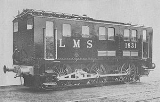
LMS diesel shunter 1831
Encyclopedia
This was the first experimental diesel shunter of the London, Midland and Scottish Railway
(LMS) — the company which pioneered diesel shunting
in the UK — nominally rebuilt by the former Midland Railway
's Derby Works
from a 1377 Class
0-6-0T steam locomotive originally built in September 1892 by the Vulcan Foundry
, whose number it inherited (1831), though very little of the steam locomotive was actually re-used. Of itself, it was not very successful, but it did provide useful data for the further development of the diesel shunter design. It was withdrawn from service in September 1939 and converted to a mobile power unit, emerging in its new guise as MPU3 in November 1940. It was scrapped in the 1950s, though sources disagree exactly when.
London, Midland and Scottish Railway
The London Midland and Scottish Railway was a British railway company. It was formed on 1 January 1923 under the Railways Act of 1921, which required the grouping of over 120 separate railway companies into just four...
(LMS) — the company which pioneered diesel shunting
LMS diesel shunters
The London, Midland and Scottish Railway pioneered the use of diesel shunting locomotives in Great Britain. The variety of experimental and production diesel shunters produced by the LMS is summarised below...
in the UK — nominally rebuilt by the former Midland Railway
Midland Railway
The Midland Railway was a railway company in the United Kingdom from 1844 to 1922, when it became part of the London, Midland and Scottish Railway....
's Derby Works
Derby Works
The Midland Railway Locomotive Works, known locally as "the loco" comprised a number of British manufacturing facilities in Derby building locomotives and, initially, rolling stock in Derby, UK.-Early days:...
from a 1377 Class
Midland Railway 1377 Class
The Midland Railway 1377 Class is a class of steam locomotive. They were introduced in 1878 by Samuel W. Johnson based on an earlier 1874 design. Up to 1891, 185 were built: 165 by Derby Works and the last 20 by the Vulcan Foundry....
0-6-0T steam locomotive originally built in September 1892 by the Vulcan Foundry
Vulcan Foundry
Vulcan Foundry was a British locomotive builder sited at Newton-le-Willows, Lancashire .-History:It was originally opened in 1832 as Charles Tayleur and Company to produce girders for bridges, switches and crossings, and other ironwork following the opening of the Liverpool and Manchester Railway...
, whose number it inherited (1831), though very little of the steam locomotive was actually re-used. Of itself, it was not very successful, but it did provide useful data for the further development of the diesel shunter design. It was withdrawn from service in September 1939 and converted to a mobile power unit, emerging in its new guise as MPU3 in November 1940. It was scrapped in the 1950s, though sources disagree exactly when.

